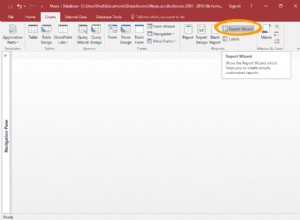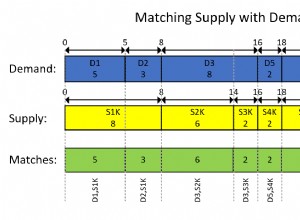Voici une requête qui vous donnera cela et plus encore (regardez le WHERE clause pour le nom de proc stocké):
SELECT
[sJOB].[job_id] AS [JobID]
, [sJOB].[name] AS [JobName]
, [sJSTP].[step_uid] AS [StepID]
, [sJSTP].[step_id] AS [StepNo]
, [sJSTP].[step_name] AS [StepName]
, CASE [sJSTP].[subsystem]
WHEN 'ActiveScripting' THEN 'ActiveX Script'
WHEN 'CmdExec' THEN 'Operating system (CmdExec)'
WHEN 'PowerShell' THEN 'PowerShell'
WHEN 'Distribution' THEN 'Replication Distributor'
WHEN 'Merge' THEN 'Replication Merge'
WHEN 'QueueReader' THEN 'Replication Queue Reader'
WHEN 'Snapshot' THEN 'Replication Snapshot'
WHEN 'LogReader' THEN 'Replication Transaction-Log Reader'
WHEN 'ANALYSISCOMMAND' THEN 'SQL Server Analysis Services Command'
WHEN 'ANALYSISQUERY' THEN 'SQL Server Analysis Services Query'
WHEN 'SSIS' THEN 'SQL Server Integration Services Package'
WHEN 'TSQL' THEN 'Transact-SQL script (T-SQL)'
ELSE sJSTP.subsystem
END AS [StepType]
, [sPROX].[name] AS [RunAs]
, [sJSTP].[database_name] AS [Database]
, [sJSTP].[command] AS [ExecutableCommand]
, CASE [sJSTP].[on_success_action]
WHEN 1 THEN 'Quit the job reporting success'
WHEN 2 THEN 'Quit the job reporting failure'
WHEN 3 THEN 'Go to the next step'
WHEN 4 THEN 'Go to Step: '
+ QUOTENAME(CAST([sJSTP].[on_success_step_id] AS VARCHAR(3)))
+ ' '
+ [sOSSTP].[step_name]
END AS [OnSuccessAction]
, [sJSTP].[retry_attempts] AS [RetryAttempts]
, [sJSTP].[retry_interval] AS [RetryInterval (Minutes)]
, CASE [sJSTP].[on_fail_action]
WHEN 1 THEN 'Quit the job reporting success'
WHEN 2 THEN 'Quit the job reporting failure'
WHEN 3 THEN 'Go to the next step'
WHEN 4 THEN 'Go to Step: '
+ QUOTENAME(CAST([sJSTP].[on_fail_step_id] AS VARCHAR(3)))
+ ' '
+ [sOFSTP].[step_name]
END AS [OnFailureAction]
FROM
[msdb].[dbo].[sysjobsteps] AS [sJSTP]
INNER JOIN [msdb].[dbo].[sysjobs] AS [sJOB]
ON [sJSTP].[job_id] = [sJOB].[job_id]
LEFT JOIN [msdb].[dbo].[sysjobsteps] AS [sOSSTP]
ON [sJSTP].[job_id] = [sOSSTP].[job_id]
AND [sJSTP].[on_success_step_id] = [sOSSTP].[step_id]
LEFT JOIN [msdb].[dbo].[sysjobsteps] AS [sOFSTP]
ON [sJSTP].[job_id] = [sOFSTP].[job_id]
AND [sJSTP].[on_fail_step_id] = [sOFSTP].[step_id]
LEFT JOIN [msdb].[dbo].[sysproxies] AS [sPROX]
ON [sJSTP].[proxy_id] = [sPROX].[proxy_id]
WHERE [sJSTP].[command] LIKE '%MyStoredProc%'
ORDER BY [JobName], [StepNo]
Le crédit doit aller à l'article Querying SQL Server Agent Informations sur l'emploi par Dattatrey Sindol pour la plupart des requêtes ci-dessus.




